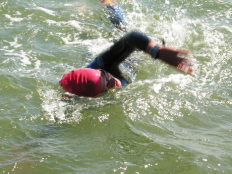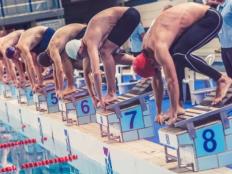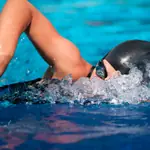5. Breathing as Rotation, not Head Lift
If we didn't have to breathe, swimming would be much easier. But you are a new, inexperienced swimmer and you're a little freaked out about it. You want to get to that breath as soon as possible. The air is up and the water is down. You instinctively want to lift your head up to the air to breath. You do this by pushing down on the water. This is exactly what you DO NOT want to do.
- Rushing the breath means that you've started your pull early. You've now taken your arms, your very effective balancing tools, out of your front quadrant and moved them closer to the lungs, your fulcrum. Your legs begin to drop.
- At the same time you've lifted your head up toward the air. Anything above the water pushes something else down. This forces your legs to drop more, increasing drag.
As an inexperienced swimmer you MUST realize that your method of breathing (i.e. push down and lift your head so you can get to air NOW) is completely counter to what you should be doing and is the source of your problems.
Instead, you want to:
- Maintain front quadrant as long as possible.
- Roll your head toward the air with your body as it naturally rotates.
- Breathe with one goggle out of the water and with zero head lift. Imagine there is a spike driven through the top of your head to your spine. Your head simply rotates along the axis of that spike; it does not lift.
- When you do begin to pull, your hand is directed rearward, not downward. Pushing downward creates lift, forcing the head up and dropping the legs.
The ability to maintain front quadrant swimming deep into the breathing stroke is absolutely critical. Many triathletes learn to swim great front quadrant on their non-breathing strokes, only to fall apart when breathing.
6. Kick In the Tube
Horizontal body position creates a small tube. Rotation along your long body axis reduces the frontal area of the tube further and allows you to transfer the rotary power of your core into your pull. Finally, a narrow kick (no wider than the tube) with ?exible ankles keeps everything inside the tube and therefore more streamlined.
Triathletes with a running background typically have very tight ankles, making it difficult for them to point their toes and keep their feet inside the tube. If you have tight ankles, try sitting on your feet while you watch TV, gently stretching your ankles.
7. 70 Percent Body Position, 30 Percent Propulsion
Notice that we haven't once spoken about what you probably thought was the key to faster swimming: grabbing more water with a stronger pull. For you, the adult swimmer/triathlete, swimming is 70 percent body position, 30 percent propulsion. It doesn't make sense to talk about putting a bigger engine into a barge. Turn that barge into a long, streamlined hull first, and then work on putting a bigger engine into it.
In summary, for the majority of triathletes, swimming faster is akin to learning to play a musical instrument—a skill that's learned and improved through focused technique instruction and practice, not by banging on the piano keys for hours and hours. Put down your training hat and focus on learning how to "play" your swim technique correctly.
We'd like to help you! Download our FREE Endurance Nation Swim Clinic eBook.
 Sign up for a swim clinic.
Sign up for a swim clinic.
- 2
- of
- 2
About the Author

Get ACTIVE on the Go


Meet Mobile
Swim smarter: heats, lane assignments and real-time results in the palm of your hand.
Available for iOS | Android







Discuss This Article